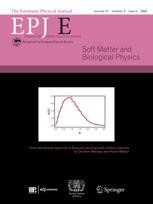Investigating the Flow of Fluids with Non-Monotonic, ‘S-shaped’ Rheology
Analysis of cornstarch suspensions under different stresses suggests that some fluids with non-monotonic rheology can segregate into regions of high and low viscosity in a capillary tube.
New York | Heidelberg, 28 October 2024
 Water and oil, and some other simple fluids, respond in the same way to all levels of shear stress and, as termed Newtonian fluids, their viscosity is constant for all stresses although it will vary with temperature. Other non-Newtonian fluids exhibit much more complex patterns of behaviour under different stresses and pressure gradients. Laurent Talon and Dominique Salin from Université Paris-Sacly, Paris, France have now shown that, under certain circumstances, cornstarch suspensions can display a banding pattern with alternating regions of high and low viscosity. This work has been published in the journal EPJ E.
Water and oil, and some other simple fluids, respond in the same way to all levels of shear stress and, as termed Newtonian fluids, their viscosity is constant for all stresses although it will vary with temperature. Other non-Newtonian fluids exhibit much more complex patterns of behaviour under different stresses and pressure gradients. Laurent Talon and Dominique Salin from Université Paris-Sacly, Paris, France have now shown that, under certain circumstances, cornstarch suspensions can display a banding pattern with alternating regions of high and low viscosity. This work has been published in the journal EPJ E.
Non-Newtonian fluids may exhibit shear thinning, where the viscosity decreases with stress; common examples include ketchups and sauces that can appear almost solid-like at rest. The reverse is shear thickening, in which viscosity increases with stress. Some suspensions exhibit a property called discontinuous shear thickening (DST): “At low shear stress [these fluids] behave like Newtonian fluids, but at a certain stress value the viscosity increases very steeply,” explains Talon.
In 2014, Matthew Wyart of New York University, NY, USA, and Michael Cates of the University of Edinburgh, Scotland, proposed a similar but even more counter-intuitive and interesting model: a so-called ‘S-shaped’ rheology where the viscosity of a fluid first increases with increasing stress and then decreases.
Talon and Salin set out to investigate the plausibility of this simulated rheology using a suspension of cornstarch in a straight, cylindrical capillary tube. They observed the expected non-monotonic relationship between pressure and flow rate, but not exactly as predicted: the flow rate initially increased with pressure but then suddenly decreased. “Assuming that the Wyart-Cates model is essentially correct, one solution that would match what we observed could be a ‘rheological segregation’ or ‘streamwise banding’ in the tube, in which some regions have a high viscosity and others a lower one,” explains Talon. “We are continuing to investigate the validity of this proposal, both experimentally and using numerical simulations.”
Reference: Talon, L., Salin, D. On pressure-driven Poiseuille flow with non-monotonic rheology. Eur. Phys. J. E 47, 52 (2024). https://doi.org/10.1140/epje/s10189-024-00444-5
Further Information
For more information visit: www.epj.org
Services for Journalists
The full-text article is available here.
Contact
Sabine Lehr | Springer | Physics Editorial Department
tel +49-6221-487-8336 | sabine.lehr@springer.com
